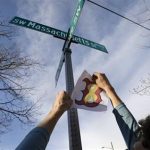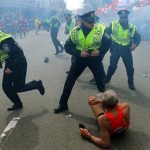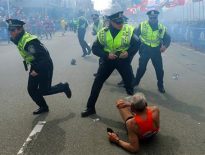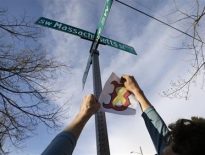BOSTON (AP) — This year’s Boston Marathon had seemed so normal.
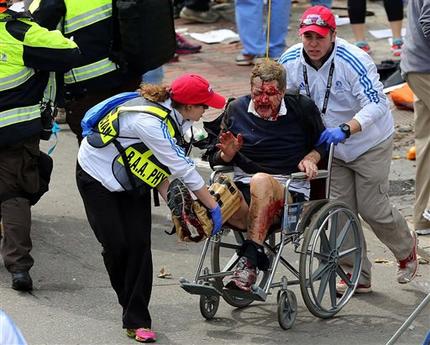
The winners were a man from Ethiopia and a woman from Kenya, and even runners two hours behind raised their arms as they finished, ecstatic just to have made it to the end of one of the most grueling 26.2-mile marathon courses.
—
EDITOR’S NOTE: Boston sports writer Jimmy Golen was covering his 18th Boston Marathon when he heard the bombs go off at the finish line. This is his account of how it unfolded.
—
Volunteers were on hand to catch those who collapsed as they crossed the blue and yellow finish line. Spectators cheered not just for family members but for every “Dan” or “Alan” smart enough to write his name on his shirt.
Then I heard the first blast. I turned to see gray smoke billowing from the north side of Boylston Street and rising over the photo bridge at the finish line. A few seconds later came another blast.
I did what I was trained to do: I called the office and told them what little I knew: “There were two explosions at the finish line of the Boston Marathon.” I wouldn’t be able to get through on my cellphone again for hours. I texted my wife to tell her I was safe, though she didn’t know what had happened yet.
No one did, really. It could have been a gas explosion, but even without an explanation it was clear that people were hurt. The second blast made it likely they were intentional, and it made me worry that there could be more. I walked toward the damage, more than anything else because I felt it was no more dangerous there than anyplace else in the area.
Race workers in yellow volunteer jackets and police in yellow safety vests were running past me. EMTs carried their gear or pushed empty wheelchairs, followed soon by doctors in their white volunteer jackets. Runners continued to run, stopping their watches as they crossed the finish line, now confused as well as tired.
I saw people crying. Runners and volunteers and family members. Police began clearing the area. I saw people turned away, pleading with officials to get through so they could see their family members.
I saw two people in civilian clothes carrying a woman, who was not wearing running gear, with one arm over each shoulder and one leg in each arm. Blood was gushing from her leg. A Boston police officer went by, pushed in a wheelchair. His pants had a small tear near the ankle, and blood was dripping from his heel. Ambulances and police vehicles sped down Boylston into the foot traffic. It seemed obvious that the worst injuries were still to come.
Unable to get through on my cellphone, I went back to the media workroom so I could communicate with my editors on my laptop. The building would soon be sealed. I was stuck there for the next five hours, unable to report on the scene of the disaster, unable to leave.
Reporters covering the marathon generally work from race headquarters in the Fairmont Copley hotel. It is a lush ballroom with a fresco ceiling and plaster frieze and large arched and curtained windows that, on Patriots Day, are blocked by a 6-foot high, 30-foot long tracking board that updates the media on the progress of the race. It can be a sterile way to experience what is often an exciting occasion.
I had grown familiar with the pace of the day: a slow buildup to the finish, then a flurry of activity as a series of winners – first the wheelchairs, then the women and men – arrived in Copley Square. I could usually count on things to settle down by midafternoon. After my stories are edited and sent on The Associated Press wire, I like to head out to the course get a feel for how the day went.
I remember last year the smell of sunscreen and the steady parade of competitors being ushered or wheeled to the medical tent to be treated for dehydration. This year’s race didn’t seem to offer any of the usual sidelights: neither unusual weather nor a surprising American contender nor even the question of trying to figure out whether the Robert Kiprono Cheruiyot of Kenya who won in 2010 was related to the Robert Kipkoech Cheruiyot of Kenya who had won four times before.
I went looking for a friend who was expected to come in around that time. I walked through the VIP stands, trying to keep one eye on the course and one on the stands, where her family would be waiting. As I reached the end of the bleachers, I saw her run past.
“Go, Laura!” I shouted, and wove my way back toward the finish line, flashing my media pass to get onto the course.
I caught up with her and walked with her while she picked up a bottle of water. We had barely crossed Dartmouth Street, less than a block from the finish, when we were shaken by the first explosion.
I had been through bomb scares before; I remember that my venue was evacuated during the Salt Lake City Olympics, five months after Sept. 11, 2001, because someone left a backpack behind. There’s a twinge of fear, but it’s more of an inconvenience for a reporter on deadline because they’ve all been false alarms until now.
Nothing was like hearing rumors that another bomb had been found “in a nearby hotel” while I was holed up in a nearby hotel. I paced around the lobby looking for someone in authority to talk to and bumped into Greg Meyer, the 1983 champion and the last American man to win. He said he ran the race with his sons and had finished a few minutes before the blasts.
People outside Boston, people who aren’t runners, are likely to think of the Boston Marathon as a sporting event, but it is really at least four different events at once.
There is the elite athlete race, the one shown on television that usually ends with a Kenyan handed a silver trophy and crowned by an olive wreath. There are the recreational runners who train for years to make the qualifying time, then spend another year preparing for the hilly trip from Hopkinton to Boston’s Back Bay. There are the runners who get into the race by promising to raise money for charity – a tradition that has collected more than $128 million over the past 25 years.
And then there is the 26.2-mile parade in which hundreds of thousands line the course on Patriots Day, when schools and many businesses are closed for the day.
“This is an event that brings people together. Not this kind of stuff,” Meyer said. “I don’t get it.”
Maybe it’s the day off from work, or maybe it’s the fact that everyone knows someone who is running, but the people of Boston – not necessarily the sports fans, but the people who live here – take pride in the marathon. First run in 1897, when about 15 local runners drew a line in the dirt at Metcalf’s Mill out in Ashland, it is the longest-running annual race at the distance and, most agree, the world’s most prestigious.
The field has grown to include women and wheelchairs and thousands of runners who struggle to qualify for it – just once.


